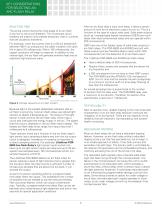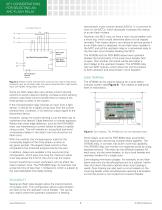 Website:
Littelfuse
Website:
Littelfuse
Group: Littelfuse
Catalog excerpts

KEY CONSIDERATIONS FOR SELECTING AN ARC-FLASH RELAY WHITE PAPER
Open the catalog to page 1
KEY CONSIDERATIONS FOR SELECTING AN ARC-FLASH RELAY WHAT TO LOOK FOR IN AN ARC-FLASH RELAY to 50 milliseconds later1. Because an arc flash can draw a fraction of bolted-fault current, especially in its initial stages, circuit breakers alone should not be relied upon to distinguish between the arcing current and a typical inrush current. This white paper informs specifying engineers, original equipment manufacturers, designers, and end users about the most important features in arc-flash relay technology so that they can select the best relay for their application. With an arc-flash relay,...
Open the catalog to page 2
KEY CONSIDERATIONS FOR SELECTING AN ARC-FLASH RELAY REACTION TIME After an arc-flash relay’s input time delay, it takes a certain amount of time for its electronic output to turn on. This is a function of the type of output relay used. Solid-state outputs (such as, insulated gate bipolar transistors (IGBTs) are much faster than electromechanical relays and can operate within 200 microseconds. The arcing current during the initial stage of an arc flash is too low to trip circuit breakers. This is because circuit breakers are sized to only tolerate temporary rises in currents that are caused...
Open the catalog to page 3
KEY CONSIDERATIONS FOR SELECTING AN ARC-FLASH RELAY HEALTH MONITORING If the sensor has detected a fault, then the blinking light will turn solid. This allows the user to quickly and efficiently identify where the fault is located. People often say, “A chain is only as good as its weakest link.” Health monitoring ensures that the system is in good operating condition. From the sensors to the output of the arc-flash relay trip circuitry, the relay should monitor every applicable component within the system. EASE OF INSTALLATION The easiest-to-install arc-flash relays do not need PC...
Open the catalog to page 4
Small electrical panels should only use arc-flash relays that are easy to install. Beyond feeder switchgear cabinets, arc-flash protection can be extended to transformers, power converters, and motor control centers. SOFTWARE A few arc-flash relays, including the PGR-8800 and the AF05000, have software with an event logging feature. This is useful for tracking trends in the system's performance. It should record the specific sensor that started the fault, which will make troubleshooting easier. Both the PGR-8800 and AF0500 relays can log up to 1000 events, and the PGR-8800 also includes...
Open the catalog to page 5
KEY CONSIDERATIONS FOR SELECTING AN ARC-FLASH RELAY downstream motor control centers (MCCs). It is common to work on live MCCs, which drastically increases the chance of an arc-flash incident. However, the MCC may not have a main circuit breaker with a shunt trip, which would otherwise allow it to be tripped remotely. That means there is no method to remove power if an arc-flash event is detected. An arc-flash relay installed in the MCC and tell the upstream relay or a networked relay to trip the main circuit breaker feeding the MCC. Point Light Sensor The AF0500 and the PGR-8800 relays...
Open the catalog to page 6
KEY CONSIDERATIONS FOR SELECTING AN ARC-FLASH RELAY BUILD A CUSTOMIZED ARC-FLASH SYSTEM WITHOUT COMPLEX PROGRAMMING OR CONFIGURATION RELATED ARC-FLASH RELAY INFORMATION Connect the AF0100 and AF0500 together to design a rightsized protection system. Use the innovative digital input and output terminals to add sensors or zones. Access information about the arc-flash relays referenced in this paper. AF0100 SYSTEM 2 zones 4 sensors per zone 1 relays per zone AF0100 Adds 2 sensors and outputs to Zone 1 Application Guide Product Page Datasheet PGR-8800 AF0100 Adds 2 sensors and outputs to Zone 2...
Open the catalog to page 7
FOR MORE INFORMATION, VISIT LITTELFUSE.COM/ARCFLASH Disclaimer Notice – Information furnished is believed to be accurate and reliable. However, users should independently evaluate the suitability of and test each product selected for their own applications. Littelfuse products are not designed for, and may not be used in, all applications. Read complete Disclaimer Notice at www.littelfuse.com/product-disclaimer.
Open the catalog to page 8All Littelfuse catalogs and technical brochures
-
Fuse Fundamentals
20 Pages
-
INDUSTRIAL CIRCUIT PROTECTION
292 Pages
-
SURGE PROTECTIVE DEVICES
32 Pages
-
HIGH-SPEED SEMICONDUCTOR
72 Pages
-
Power Semiconductor & IC
133 Pages
-
Dc Disconnect Switches
2 Pages
-
ESR_Fuse_Datasheet
6 Pages
-
ELECTRICAL COILS
2 Pages
-
PRODUCTS FOR AGRICULTURE
36 Pages
-
CIRCUIT PROTECTION
15 Pages
-
MSL Classification
2 Pages
-
SE-325 SERIES (PGM-8325)
1 Pages
-
SE-CS10 SERIES
2 Pages
-
ECSW SERIES
3 Pages
-
LSR-0
1 Pages
-
LSRU SERIES
2 Pages
-
LSRX / LSRX-C SERIES
2 Pages
-
50R-400-ALT
1 Pages
-
ALT SERIES
2 Pages
-
05903300 & 05903500 RELAYS
1 Pages
-
05930100 & 05930800 RELAYS
1 Pages
-
05931300 & 05931600 RELAYS
1 Pages
-
QJxx30LH4 series
6 Pages
-
Thyristors QJ8012xHx Series
8 Pages
-
30KPA-HRA Series
7 Pages
-
AK1-Y Series
4 Pages
-
QJxx40xx Series
8 Pages
-
TS Series
11 Pages
-
Littelfuse SIDACtor Products Catalog
239 Pages
-
Electronic Fuse Products Catalog
409 Pages
-
Passenger Car Catalog
60 Pages
-
Polyfuse PPTC Catalog
128 Pages
-
POWRGARD Electrical Product Catalog
202 Pages
-
Protection Relays SSAC Catalog
524 Pages
-
Sensors Products Catalog
20 Pages
-
SIDACtor Catalog
239 Pages
-
TVS Diode Array (SPA) Catalog
215 Pages
-
Varistors Catalog
254 Pages
-
SOLAR PRODUCTS CATALOG
28 Pages
-
MP8000
2 Pages
-
MicroPlex® SSR18 AND SSR30
2 Pages
-
606 Series
3 Pages
-
ST Series
3 Pages
-
885 Series Fuse
3 Pages
-
MicroPlex® 7X, 7H, & 7L
2 Pages
-
TPSMB Series
6 Pages
-
TPSMD Series
6 Pages
-
ISOBUS SYSTEM
2 Pages
-
POLYFUSE®
6 Pages
-
Passenger Car Solutions
60 Pages
-
TVS Diode Catalog
174 Pages
-
Switching Thyristor Product Catalog
442 Pages
Archived catalogs
-
AFTERMARKET PRODUCTS CATALOG
136 Pages
-
AFTERMARKET PRODUCTS CATALOG 2018
132 Pages
-
Littelfuse Thyristor Catalog
467 Pages




































































































